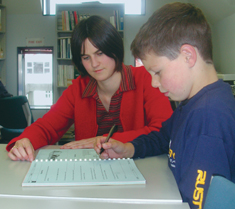![]() THE QUALITY LEARNING CIRCLE: ENHANCING TEACHER LEARNING
THE QUALITY LEARNING CIRCLE: ENHANCING TEACHER LEARNING
![]()
Susan Lovett
This
study tracked the learning journeys of eight teachers as they
endeavoured to improve their assessment practices by studying
NEMP reports (sent to all New Zealand schools) within the structure
of a quality learning circle (QLC). The QLC provides teachers
with opportunity to share professional conversations around a
common theme and to work together to improve their work practices. |
| The
eight teachers were selected for the study because they expressed
interest in this in a questionnaire sent to schools in 1998 (repeated
in 2000) to gauge the impact of NEMP reports in schools over a two-year
period. The teachers, who between them taught Years 2 to 8 classes
in different schools, came together fortnightly during 2000 for QLC
meetings in school time to explore the NEMP reports, with payments
made for their teacher release and travel over |
the year. Data sources included observations of QLC and school-based meetings, document analyses, and interviews with the teachers throughout the year. As a condition of participation in the study, the teachers reported during QLC meetings on their trials of NEMP assessment tasks in their classrooms. They also visited one another’s classrooms as observers. |
•
The teachers liked the regular opportunities to talk with one another
about how they were using the NEMP assessment tasks.
|
•
They welcomed the opportunity to teach each other and pass on their
learning to other teachers at their schools and found classroom application
helped them to become more enthusiastic learners. Diane said: ‘I think being able to share with each other the things we were doing . . . has prodded us into, “Oh, that looks all right. Oh, I think I can handle that one,” and I’ll have a go at it.’ Mavis said: ‘Here we are having to do an equal amount . . . because we are all helping each other…I think the QLC is good in that . . . we have some sort of ownership in it.’ Katrina said: ‘When you know you have another meeting coming, you think, “Oh I must remember to do something for that,” so you get the books out . . . It’s not fair [to the group] unless I have done preparation or follow up.’ |
![]()
| The
study showed that teachers relish opportunities to focus together
on issues of classroom practice within a small, collegial group in
school time. According to the teachers, when learning is structured
in this way and is accompanied with visits to colleagues’ classrooms,
it is more effective than learning undertaken during conventional
whole-staff professional development sessions. The experience of the eight QLC teachers also suggests a need to divert energies away from issues of content and coverage during |
professional
development and to concentrate on how teachers can establish effective
reciprocal learning relationships with their colleagues. While such
learning takes time and deserves meeting time with paid teacher release
within the school day, teachers’ learning is too important to
keep in the ‘tired slots’ at the end of the day. If teachers
are to be active and effective learners, then schools must provide
the conditions to make this a reality. The QLC provides them with
one possible way of doing so. |
